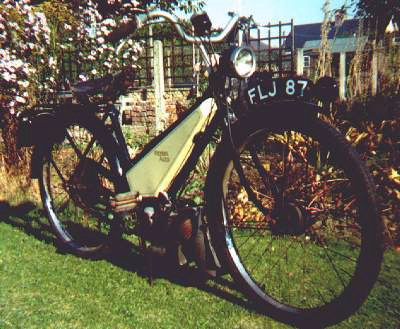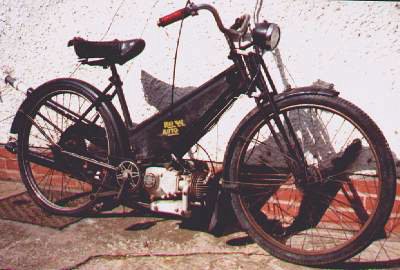 Go
to the Archive index
Go
to the Archive indexThe earliest mention of the Raynal Mfg.Co.Ltd. in Kelly's Directory for Birmingham appeared in 1936, listed as cycle manufacturers at Woodburn Road, Handsworth, B21. The final entry was in 1950. Woodburn Road together with Foundry Lane, Booth Street and Anne Road forms a square that enclosed much engineering activity. Just to the south of Foundry Lane stood the Soho Foundry where James Watt developed and made the steam engines that were to change the landscape of our cities and alter the lifestyle of millions. A 1949 map shows a cycle works on the north side of Woodburn Road but Dunelt also had premises in the same road. The cycle works stood beside Hockley Brook - once an important requirement for any industrial activity, initially as a direct source of power, later as the 'raw material' for steam. Raynal's autocycle, the Raynal-Auto, was the original Junior powered machine, and was launched in 1937 for the 1938 season. At the 1938 Earls Court Show Review there were two Raynal machines on offer: the 'de-Luxe' and the 'Popular'. The 'de Luxe' had a 98cc Villiers Junior engine; 9 pint [5 litre] fuel tank; 1¾ inch [44mm] tyres; price with lighting, horn & licence holder £18 18s 0d [£18.90]. This model employed a leaf spring front fork suspension, the upper end of the spring was secured in the lamp bracket and the lower end was held by an attachment to the fork crown. There were friction discs between the moving parts of the fork assembly and twin grease nipples were fitted. For a guinea less, the 'Popular' model came without the spring fork. The design of the Raynal was derived from the prototype autocycle built by G H Jones in 1936. Although the proportions of the frame differ from Mr Jones's machine, many features of the Raynal betray its ancestry. The leaf spring fork in particular is the same as on the Jones. The design of the tank and frame, along with the use of forward-facing dropouts for the rear wheel, also reflect George Jones's design. Being derived directly from the Jones prototype, the Raynal should have been the first production model of a Villiers Junior powered autocycle to hit the market. However, Excelsior also brought out their 'Autobyk' at the same time. Popular rumour suggests that Villiers, being unsure of Raynal's ability to make a success of the autocycle, leaked the design to Excelsior to increase the chances of large volume sales for the Junior engine.
Colour scheme was all black with a cream fuel tank carrying gold block letter transfers either side. Clips attached to the large rear carrier carried the inflator. Villiers supplied the lighting set and a long tail pipe ran from the cast alloy expansion box beneath the engine to the rear of the machine. Althought the rear brske was a conventional drum, it was applied by back-pedalling, leaving the rider free to concentrate on the decompressor and clutch on the left handlebar and the throttle and front brake levers on the right. An additional handlebar lever disengaged ther rear brake mechanism - so the machine could be wheel backwards without locking up. Heavier gauge spokes were employed on the brake side of the rear wheel. A rod on the left side of the tank linked to the carburettor air filter which could be 'choked' from the saddle, without dismounting. The low riding position due to the frame geometry inspired confidence in spite of the 26" wheel size.

1939 Raynal-Auto 'Popular'
In December 1939 prices had risen to £22 0s 0d [£22.00] for the 'de-Luxe' and £20 10s 0d [£20.50] for the 'Popular'. All-up weight was quoted as 95lbs [43kg] and ground clearance 4 3/8 inches [111mm]. The power unit was the new 5-port Villiers Junior de Luxe with improved performance. In December 1947, details of the new central spring controlled front fork were announced. At this time engine side covers and built-in leg-shields were also fitted. Ground clearance at the pedals was 3½ inches [89mm]. The colour of the fuel tank had changed to black and the price was now £52 19s 6d [£52.48].

Post-war Raynal-Auto
In 1949 Villiers introduced the 2F engine to replace the JDL but Raynal never produced a machine using this power unit. Production stopped in 1950, a total of about 8,000 machines having been produced. However, A B Jackson, one of the directors of the Raynal company, produced a 2F powered autocycle under his own name.
The next article in this series will describe the Rudge autocycle.
First published August 1991, revised June 1999